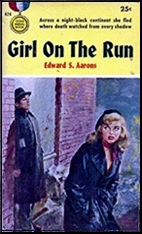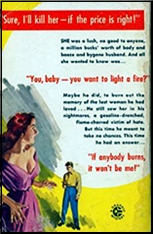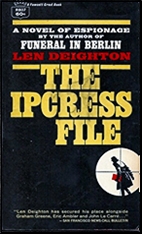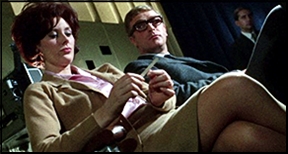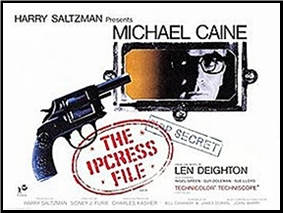FIRST YOU READ, THEN YOU WRITE
by Francis M. Nevins
When I devoted one of last year’s columns to John Roeburt’s Jigger Moran novels, I didn’t promise to do another column on Roeburt but suggested that I might. Since then I’ve decided that he deserves not one but two more. This month for space reasons I’ll limit myself to the rest of his hardcover books.
His first two novels, JIGGER MORAN (1944) and THERE ARE DEAD MEN IN MANHATTAN (1946), I discussed before. I wish I could say more about his third, SENECA U.S.A. (Samuel Curl, 1947), but I’ve never seen a copy and it’s a hard book to find. What this stand-alone novel is about becomes fairly clear from the Kirkus review:

“Portrait of a small town, almost any small town, and the postwar forces of unrest, labor union and racial, reflected in the story of Shep Ward, newspaper editor and party line follower of a rich, reactionary publisher….†Shep’s wife “leaves him thinking he has lost all decency of point of view.†Then the publisher is shot and a Jew is charged with the murder, “only because of anti-semitism. Shep, forfeiting caution for the truth, airs the whole thing in an edition of his paper.†The reviewer’s conclusion: “The intentions here are worthier than the actuality—which is only mediocre.â€
Critic Irving Howe covered SENECA and four other novels with similar viewpoints in an essay for Commentary (January 1, 1948), opining that all five “range from the bad to the downright ludicrous….†What he thought about Roeburt’s book specifically I can’t say because only the first page of his essay is downloadable on the Web.
As if scared out of the mainstream by reactions to his third novel, Roeburt returned in his fourth to the tough-guy genre and a character modeled on the later Bogart. Like any respectable roman noir, TOUGH COP (Simon & Schuster, 1949) opens at night. Johnny Devereaux, 41 years old and just retired after twenty years on the NYPD — although he somehow has a month or so to use his badge any way he pleases — is about to drive off from a 52nd Street nightclub when a lovely young woman flings open the passenger door of his Buick convertible and begs for his help.

Jennifer Phillips was raised by and lives with an obese old man, known for his scathing reviews of Broadway plays, who claims to be her father. But as she’s matured from age ten to twenty, his interest in her seems to have become, let’s say, non-paternal. Devereaux agrees to talk to the woman who raised Jennifer as a child but finds her dead in her hotel room and gets slugged by someone hiding in her closet, who turns out to be a small-time subway pickpocket recently paroled from Sing Sing after serving 14 months on a firearms charge.
The drama critic who claims to be Jennifer’s father and supposedly “used rattlesnake venom for ink†(although the two samples of his reviews that Roeburt gives us strike me as cutesy rather than venomous) turns out to be “a sybarite, unnatural, an obscene and gilded pervert.†Homosexual, of course.
I need hardly add that this “dandified and dissolute sensualist†talks like Sydney Greenstreet. Shadowing him and enlisting PI Sam Solowey to pursue other leads, Devereaux discovers that a number of the people he encounters — -a publisher of hate pamphlets, an ex-boxer turned nightclub owner — share with Jennifer Phillips and her alleged father the fact that nothing is known about their origins. (Could any writer get away with that premise in today’s high-tech age?)

In due course he finds himself looking into a 20-year-old murder and payroll robbery from which the loot was never recovered. Only one of the criminals was caught and that one was “accidentally†scalded to death in the shower at Sing Sing while the hood who slugged Devereaux was serving his sentence in the same prison. Trying to trace the backgrounds of all the people he’s run into takes Devereaux to a tough neighborhood in Brooklyn’s Williamsburg district and into several chapters of investigation that show Roeburt at his best.
At the climax he falls back on the most hackneyed “surprise†ending in the world of noir, but despite that and a few gaffes here and there — the former boxer is described as both a bantamweight and a middleweight, the dancers at Radio City Music Hall are called the Roxettes, and our old buddy the St. James Bible crops up at least twice — TOUGH COP is by far the most rewarding of the Roeburts I’ve read to date, with prose and plot kept under tight control from first page to last.
That book was followed by the third and final Jigger Moran exploit, CORPSE ON THE TOWN (1950), which I discussed a few months ago. From that point forward, radio, movie and TV work apparently occupied Roeburt full-time for a while. In the second and final Devereaux novel, THE HOLLOW MAN (Simon & Schuster, 1954), two years have passed since Johnny’s retirement and he’s vegetating at a $1000-a-week job hosting dramatized true-crime stories on live TV when, as in TOUGH COP, a lovely woman begs him to help her.

Five years earlier, struggling actress Nina Troy had secretly married boxing champ Rocky Star (born Rocco Starziano) and borne him a son. But Rocky vanished into thin air soon after the child’s birth, and Nina, now a huge success on radio and TV, is terrified that her marriage will be found to be invalid and her child illegitimate. (The only conceivable legal problem with the marriage is that Rocky had used a false name. New York law requires that people getting married have to prove their identities to the official or clergyman performing the ceremony, but I find it hard to believe that a detail of this sort would invalidate a marriage and turn any child of that marriage into what used to be called a bastard — the politically correct term today is nonmarital child — and Roeburt spends zero time exploring the legal issue. So much for any claim that he had a law degree!)
But apparently someone doesn’t want the disappearance reopened: both Nina and the sportswriter she’d previously asked for help have been savagely beaten, and soon after agreeing to look into the case Devereaux too takes some lumps, although of course they don’t stop him or even slow him down. Like CITIZEN KANE, this novel is an investigation into a vanished or (in Kane’s case) recently deceased legendary figure: Was he a Saint or was he a Swine? (Anyone wondering why I capitalized those nouns will find out shortly.)
Except for the beatings and a few shots taken at Devereaux as he and his PI friend Solowey look into Rocky’s past, there’s no crime until late in the game when one of the people closest to the missing champ is poisoned. Our tough cop, who isn’t a cop any more but unaccountably carries a badge and continues to beat up the ungodly without mercy, doesn’t crack the case until he recognizes the guy who’s been taking shots at him, after which the revelations come thick and fast.
What makes THE HOLLOW MAN unusual is the utter weirdness of Roeburt’s style. First off, he can’t seem to tell a noun apart from an adjective or verb. “…transmuting her into something gross, and chicane, and murderous.†“…a busy quarter-century of detectiving.†“[C]ould he loom the fabric?†“…{A] wisping smile could even be read on his mouth.†At least three times in the first four chapters he twists the same noun into a verb: “You jackassed every one of them,†Devereaux tells another character.
As if that weren’t enough, the pages are pockmarked with irrelevant religious allusions: crown of thorns, mote in his eye, consecrated, adoration, genuflection, incantation, resurrection, martyr, blasphemy, absolution, prayer, the list goes on and on, world without end Amen. To give one concrete example: “The truth, unholy or not, will pour like an almighty flood.†That makes three religion words out of eleven!
If you thought two types of gaffe were enough, Roeburt offers a third by capitalizing nouns no one else would: Director, Youth Monitor, Host, Narrator, Scripter, Agency Men, Control Room, Account Men, Mother, the Universe, Shadow Men, a Case, a Mourner, the Law, the Sports Page — it’s as if inside the author there were an inner German (name of Scheisskopf?) clawing to get free.
Naturally enough, wackadoodle sentences and phrases abound like warts on a — well, if you don’t know what amphibian I was about to name, you haven’t been reading these columns. Let me provide a few specimens:
“The insinuation of the room was one-dimensional.â€
“The building itself was a thing of cardboard, a fabrication of paper and glue and bits of wire that sat whimsically in the bosom of a towering futurism of iron, mortar, and steel.â€
“…as consanguine as two people can be.â€
“He was conscious of her flesh, the rich pneumasis….â€
“[He] was not kind or specie to his master….â€
“His paterfamilias, as much as his notorious side, was parcel to his legend.â€
“Marco’s style of battle was never formular.â€
“His soft tone seemed efforted….â€
“She smiled up to him. An outside smile, not from the deep manufactory of her womanhood.â€
“The tables themselves were separate islands where caste was the denominator of tenancy.â€
“The man was ephemeral, with the merest instance of solidity.â€
“[T]he stir in the detective beggared the event.â€
“The taxi-driver looked squarely at the detective, in an efforted impassivity….â€
“‘You used every histrionic, every cunning.’â€
“…as if…he, Devereaux, was but one indivisive part of the whole.â€
In his review for the New York Times (June 13, 1954), Anthony Boucher said that Roeburt “might well be called the Theodore Dreiser of the mystery novel, both because he tries harder than most to see the sociological meaning behind murder and because he couches his well-conceived novels in an almost willfully strained and graceless prose…. I found the novel as compelling as it is tortuous.†The reference to Dreiser, of whom H. L. Mencken once said that he “came into the world with an incurable antipathy to the mot juste,†makes a lot of sense but, even though I hate to disagree with Tony, to my taste THE HOLLOW MAN is somewhat less than compelling.

By the mid-1950s radio was dying and apparently Roeburt didn’t get enough television work to keep him as busy as he’d been, so he returned to writing novels, although none of them featured Devereaux or Jigger Moran or any other series character. Only two appeared in hardcover. THE LUNATIC TIME (Simon & Schuster, 1956; reprinted as DID YOU KILL MONA LEEDS?, Crest pb 3213, 1956) was described by Boucher in his Times review (August 19, 1956) as “unconventional, difficult and curiously compelling. An unsuccessful journalist, a psychotic dipsomaniac, half-involuntarily turns detective for a girl whose brother is in danger of the chair. His ultimate discovery should not surprise you, but this is one of those rare cases in which anticipation of the ending makes the novel, if anything, more fascinating.â€
Tony again mentions Roeburt’s “tortuous and somewhat strained writing†but stresses his “strong individuality and a certain morbid power.†Thanks to his review, and the longer discussion by Marcia Muller in 1001 MIDNIGHTS (1986), I think I know who killed Mona Leeds already. But I have a copy of the book and have made a date with myself to read it one of these days.

I don’t own a copy of THE CLIMATE OF HELL (Abelard-Schuman, 1958; reprinted as THE LONG NIGHTMARE, Crest pb #246, 1958) but there’s enough information on the Web to provide a good idea of what it’s about. I’ll start by quoting the Kirkus review, unnecessary dashes and all:
“Larry Stevens, a fisherman in Florida, is brainwashed into the identity of Kirk Reynolds, taken — by three men — to New York to live the life of a gilded bum, to renew his marriage with Laura, a lush, and to witness the murder of his presumed father — before his will is changed. Running away — to give himself up — -he must finally face the revelation of his own responsibility in the situation to which his sick, truant conduct has led. Up from the pulps, loud and lewd and lurid.â€
Tony Boucher’s Times review (May 25, 1958) is so much more positive it tempts me to track down a copy. He calls it “as headlong, urgent, read-in-one-desperate-sitting a narrative as has come my way in quite a while…. Roeburt’s odd, individual prose and his psychological variations on the theme give it freshness; and the perils of the impostor and the sheer evil of his criminal masters make a memorable nightmare of menace.â€
As chance would have it, while roaming the Web for more information on THE CLIMATE OF HELL I stumbled upon David Seed’s BRAINWASHING: THE FICTIONS OF MIND CONTROL: A STUDY OF NOVELS AND FILMS (Kent State University Press, 2004), which blithely gives away the surprise Roeburt was building up to. Well, I still might try to track down a copy.
